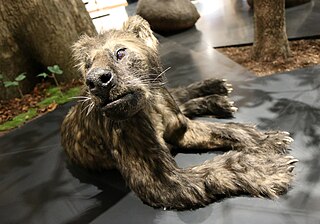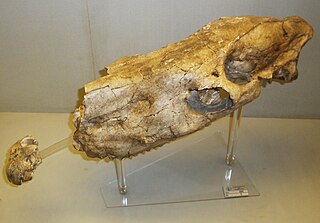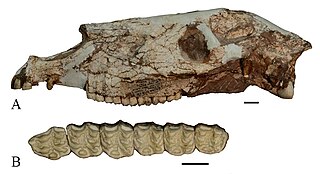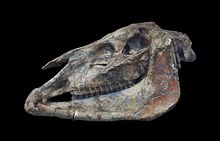
The hoatzin or hoactzin is a species of tropical bird found in swamps, riparian forests, and mangroves of the Amazon and the Orinoco basins in South America. It is the only extant species in the genus Opisthocomus which is the only extant genus in the Opisthocomidae family under the order of Opisthocomiformes. Despite being the subject of intense debate by specialists, the taxonomic position of this family is still far from clear.

The Acrocephalus warblers are small, insectivorous passerine birds belonging to the genus Acrocephalus. Formerly in the paraphyletic Old World warbler assemblage, they are now separated as the namesake of the marsh and tree warbler family Acrocephalidae. They are sometimes called marsh warblers or reed warblers, but this invites confusion with marsh warbler and reed warbler.

Amphicyonidae is an extinct family of terrestrial carnivorans belonging to the suborder Caniformia. They first appeared in North America in the middle Eocene, spread to Europe by the late Eocene, and further spread to Asia and Africa by the early Miocene. They had largely disappeared worldwide by the late Miocene, with the latest recorded species at the end of the Miocene in Africa. They were among the first carnivorans to evolve large body size. Amphicyonids are colloquially referred to as "bear-dogs".

Amphicyon is an extinct genus of large carnivorans belonging to the family Amphicyonidae, subfamily Amphicyoninae, from the Miocene epoch. Members of this family received their vernacular name for possessing bear-like and dog-like features. They ranged over North America, Europe, Asia, and Africa.

Hipparion is an extinct genus of three-toed, medium-sized equine belonging to the extinct tribe Hipparionini, who lived about 10-5 million years ago. While the genus formerly included most hipparionines, the genus is now more narrowly defined as hipparionines from Eurasia spanning the Late Miocene. Hipparion was a mixed-feeder who ate mostly grass, and lived in the savannah biome. Hipparion evolved from Cormohipparion, and went extinct due to environmental changes like cooling climates and decreasing atmospheric carbon dioxide levels.

Sinotherium is an extinct genus of single-horned elasmotheriine rhinocerotids that lived from the late Miocene to Early Pliocene. It was ancestral to Elasmotherium, demonstrating a very important evolutionary transition from nasal-horned elasmotheriines to frontal-horned elasmotheriines. Its fossils have been found in the Karabulak Formation of Kazakhstan, lower jaw and teeth have been found in Mongolia, and a partial skull is known from the upper part of the Liushu Formation of western China. Sinotherium diverged from the ancestral genus, Iranotherium, first found in Iran, during the early Pliocene. Some experts prefer to lump Sinotherium, and Iranotherium into Elasmotherium.

The evolution of the horse, a mammal of the family Equidae, occurred over a geologic time scale of 50 million years, transforming the small, dog-sized, forest-dwelling Eohippus into the modern horse. Paleozoologists have been able to piece together a more complete outline of the evolutionary lineage of the modern horse than of any other animal. Much of this evolution took place in North America, where horses originated but became extinct about 10,000 years ago, before being reintroduced in the 15th century.

Nannippus is an extinct genus of three-toed horse endemic to North America during the Miocene through Pleistocene, about 13.3—1.8 million years ago (Mya), living around 11.5 million years. This ancient species of three-toed horse grew up to 3.5 feet and weighed between 165 pounds to 199 pounds, which was around the same size as a domestic sheep.

Cormohipparion is an extinct genus of horse belonging to the tribe Hipparionini that lived in North America during the late Miocene to Pliocene. They grew up to 3 feet long.

Samburupithecus is an extinct primate that lived in Kenya during the middle to late Miocene. The one species in this genus, Samburupithecus kiptalami, is known only from a maxilla fragment dated to 9.5 million years ago discovered in 1982 and formally described by Ishida & Pickford 1997. The type specimen KNM-SH 8531 was discovered by the Joint Japan-Kenya Expedition at the SH22 fossil site in the Samburu District, a locality where several other researchers found no ape fossils.

Agnotherium is a genus of large sized carnivoran mammals, belonging to the Amphicyonidae, which has been found in Western Europe, and possibly China and Northern Africa, and lived during the Late Miocene epoch. Despite only being known from fragmentary remains, the genus notable for hypercarnivorous adaptions, which have been said to represent the "apex" among its family.

Cerro de los Batallones is a hill at Torrejón de Velasco, Madrid, Spain where a number of fossil sites from the Upper Miocene (MN10) have been found. Nine sites have been discovered with predominantly vertebrate fossils, invertebrates and plants being less represented. The first deposits were discovered accidentally in July 1991.
La Roma is a Miocene fossil site in the Teruel Province of Spain.

Hipparionini is a tribe of three-toed horses in the subfamily Equinae. They had body forms similar to modern equines, with high-crowned teeth. They first appeared in North America during the Early Miocene around 17 million years ago, before migrating into the Old World around 11.4-11 million years ago. The youngest species date to the Early Pleistocene.

Eurygnathohippus is an extinct genus of hipparionine horse. The majority of known fossils of members of this genus were discovered in Africa, where members of this genus lived during the late Miocene to Pleistocene interval. Fossils of Eurygnathohippus were also reported from the late Pliocene sediments of the Potwar Plateau in Pakistan and the Siwalik Hills in northwest India.

Anapithecus is a late Miocene primate known from fossil locations in Hungary and Austria. Many Anapithecus fossils come from the site of Rudabánya, in northern Hungary, where Anapithecus lived alongside the ape Rudapithecus. The only species in the genus, Anapithecus hernyaki, is named after Gabor Hernyák, chief geologist of the Iron Ore Works of Rudabánya.
This paleomammalogy list records new fossil mammal taxa that were described during the year 2013, as well as notes other significant paleomammalogy discoveries and events which occurred during that year.

Sivalhippus is an extinct genus of horse that lived in Africa and the Indian subcontinent during the late Miocene.

Epipliopithecus vindobonensis is an extinct species of pliopithecoid primate recovered from the Middle Miocene deposits of Devínska Nová Ves fissure in western Slovakia. Epipliopithecus is one of the few pliopithecoids for which both cranial and post-cranial fossil material has been recovered. Most pliopithecoids are known only from fossilized teeth, whereas Epipliopithecus is known from three nearly complete skeletons. As such, Epipliopithecus has greatly informed the modern understanding of pliopithecoid anatomy, locomotion, and phylogeny.

Proboscidipparion is an extinct genus of hipparionine equine. It is named after its unusual retracted nasal region of the skull, which may have supported a proboscis. Fossils have been found throughout Eurasia, from England to China. The oldest specimens are known from Asia, dating to the Early Pliocene, around 5.3-5 million years ago. The genus was one of the last surviving hipparionines, with the youngest specimen dating to the end of the Early Pleistocene, around 1 million years ago.






















